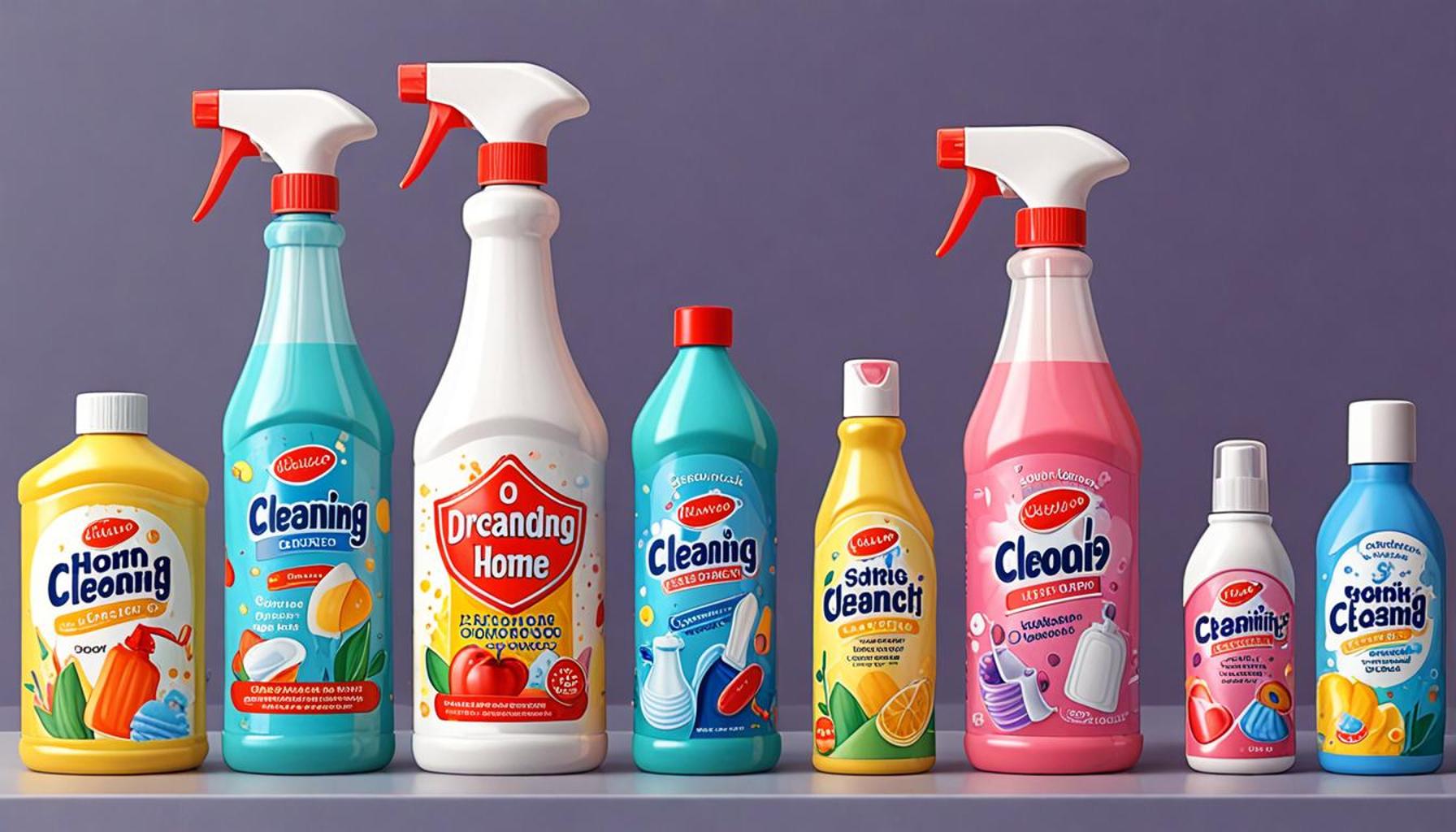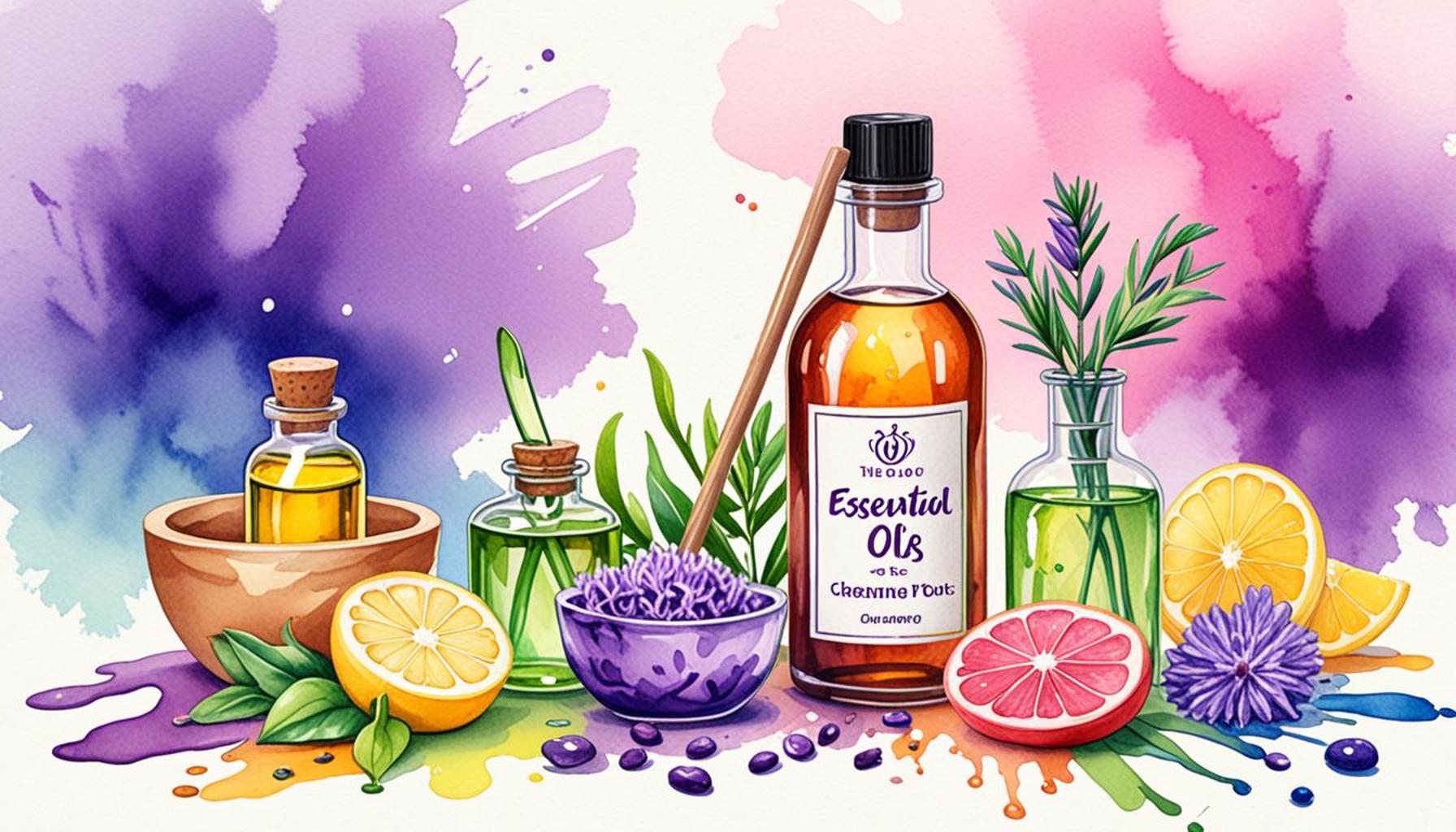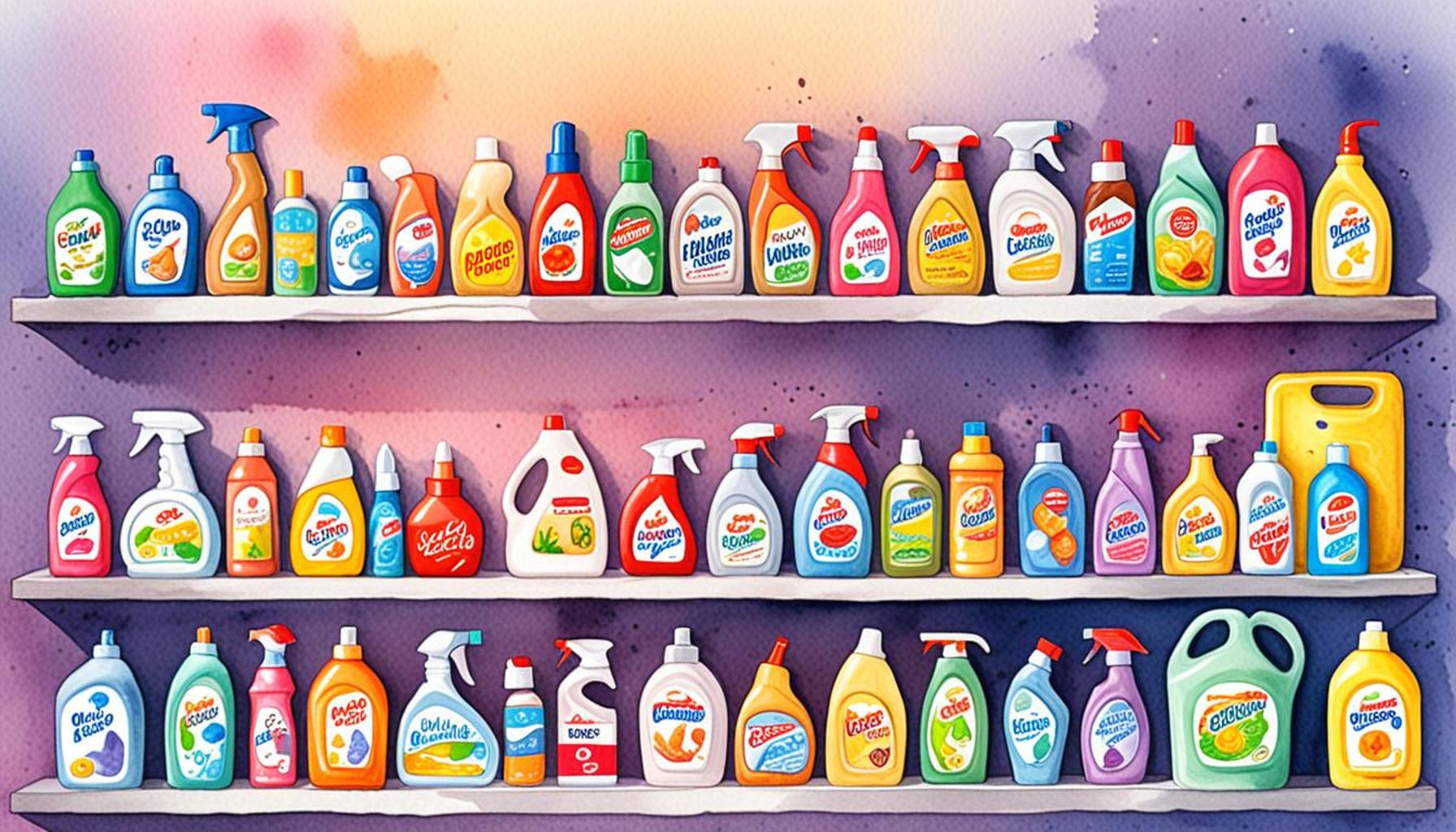Understanding Cleaning Product Labels: Deciphering Ingredients for Safer Home Environments

The Importance of Understanding Cleaning Products
Many people assume that cleaning products are safe simply because they are available on store shelves. However, understanding what’s in these products is crucial for creating a safer home environment. With numerous brands and an overwhelming array of ingredients, how can you ensure that your cleaning choices are both effective and safe?
- Consumer Awareness: There is a growing concern about indoor air quality, which can significantly impact our health. Studies have shown that indoor air can be more polluted than outdoor air, primarily due to the chemicals found in many household cleaning products. For instance, volatile organic compounds (VOCs) released from aerosol sprays can lead to headaches, dizziness, and even long-term respiratory issues.
- Ingredient Transparency: Despite an increasing number of consumers seeking transparency, many brands fail to fully disclose their ingredients. This lack of clarity can be frustrating for shoppers trying to make informed choices, especially when they encounter vague terms like “fragrance” or “cleaning agents.” These terms often mask proprietary blends of chemicals that could potentially pose health risks.
- Potential Risks: Some chemicals found in everyday cleaning products can lead to respiratory issues, skin irritations, or even long-term health problems. For example, ingredients such as ammonia and bleach, commonly found in household cleaners, can cause skin burns and respiratory distress when mixed or used in poorly ventilated spaces.
Understanding cleaning product labels is the first step in making informed decisions. Many labels contain complex chemical names and vivid marketing claims that can easily mislead consumers. By familiarizing yourself with common terms and potentially harmful substances, you can empower yourself to select products that align with your health priorities.
Decoding Cleaning Product Labels
As you dive deeper into the world of cleaning products, consider these important factors:
- What do terms like “non-toxic” truly mean? The term can vary significantly from brand to brand, with no standard definition in many countries, including the U.S.
- Which ingredients should you avoid at all costs? Common culprits include phosphates, phthalates, and certain surfactants that can have adverse effects on both health and the environment.
- Are there eco-friendly alternatives that are just as effective? The market for green cleaning products has exploded, with many brands offering plant-based solutions that are both effective and safer for your home.
By examining the fine print on your cleaning supplies, you can take proactive steps towards a healthier living space. Understanding labels, seeking transparency, and exploring eco-friendly alternatives are essential elements of making smart decisions for you and your family. Definitively, the choice of cleaning products should contribute to the quality of the air we breathe and the overall safety of our environment at home. Armed with knowledge, you can make purchases that align with a healthier lifestyle and a cleaner planet.
DISCOVER MORE: Click here for helpful tips

Decoding the Truth Behind Labels
The labeling of cleaning products can often seem like a cryptic puzzle, where vibrant graphics and catchy slogans aim to sell but may ultimately obscure the true nature of what’s inside the bottle. For consumers striving to make informed choices that benefit their household and health, it is crucial to demystify common terminologies and ingredients present in these products. A closer examination can lead to a deeper understanding of what really matters when it comes to cleanliness and safety.
Understanding Terms
Many brands prominently feature terms like “non-toxic” or “eco-friendly” on their labels, appealing to the growing consumer demand for safer products. However, it is essential to note that these terms lack uniform regulatory standards, which can lead to a wide interpretation by manufacturers. For instance, a product labeled as “natural” might still contain chemicals that are harmful to health. Therefore, it becomes imperative to look beyond marketing jargon by always checking the ingredient list.
To assist consumers in navigating this maze, organizations such as the Environmental Protection Agency (EPA) and the American Lung Association provide comprehensive resources. These institutions highlight the importance of indoor air quality and encourage transparency in labeling, urging consumers to be vigilant in their purchases.
Common Ingredients to Avoid
As you begin scrutinizing labels, it’s crucial to be on the lookout for certain ingredients associated with health risks. Awareness of these harmful components can help make safer selections:
- Ammonia: This ingredient is prevalent in many glass cleaners, but it poses several health risks, including respiratory challenges and skin irritation. Moreover, when combined with bleach, ammonia can produce toxic chloramine vapors, creating a hazardous situation.
- Phthalates: Often hidden within the term “fragrance,” these chemicals have been linked to hormonal disruptions, which can be particularly dangerous for children and pregnant women, affecting their development and health.
- Chlorine Bleach: Known for its disinfecting properties, chlorine bleach can indeed be effective but also carries risks, such as skin burns and dangerous fumes, especially when mixed with other cleaners.
Exploring Eco-Friendly Alternatives
With heightened awareness regarding the potential impact of traditional cleaning chemicals, many consumers are turning to eco-friendly alternatives. Brands such as Seventh Generation and Method have gained notoriety for their commitment to producing cleaning products derived from plant-based ingredients that deliver powerful cleaning effectiveness without exposing users to harmful substances.
Furthermore, DIY cleaning solutions are gaining popularity, using simple household ingredients like vinegar, baking soda, and essential oils to create safe, effective cleaners. For example, a mix of vinegar and water can serve as an excellent window cleaner, while baking soda can tackle tough stains and odors. These alternatives not only reduce exposure to potentially harmful chemicals but also allow for greater control over what you are using in your home.
Contributing to a Healthier Home
By taking the time to investigate cleaning product labels, consumers cultivate a more health-conscious living environment, enhancing indoor air quality and overall safety. This knowledge empowers individuals to select products that not only fulfill their cleaning needs but also help nurture a healthier home. The future is indeed leaning towards products that prioritize transparency and sustainability, and informed consumers have the power to drive this change.
In essence, the choices made today, informed by comprehensive knowledge about cleaning product labels and their ingredients, can contribute to a cleaner planet for future generations. As the industry evolves, so too does the understanding of our role as consumers in advocating for safer and healthier options. By staying informed, we not only safeguard our homes but also actively participate in creating a sustainable and safe environment for all.
Deciphering the Benefits of Understanding Cleaning Product Labels
Become an informed consumer by understanding the ingredients in your cleaning products. With the growing awareness of environmental and health impacts, knowing what goes into your cleaning supplies can lead to safer home environments. This knowledge empowers you to make choices that benefit not only your household but also the wider community and environment.
When you read and understand labels, you are better equipped to avoid harsh chemicals that might contribute to indoor air pollution. Many conventional cleaning products contain toxic substances that can trigger allergy symptoms or exacerbate asthma in sensitive individuals. By opting for products with clear labeling and recognizable ingredients, you can select safer alternatives that reduce these risks.
Understanding labels also helps identify eco-friendly cleaning products that minimize environmental hazards. Look for certifications or labels that signify a product’s sustainability, such as biodegradable ingredients or non-toxic formulations. This not only benefits your immediate surroundings but also supports the global movement towards reducing chemical waste.
| Category | Benefits |
|---|---|
| Health Safety | Avoid allergens and toxic chemicals; protects children and pets. |
| Environmental Impact | Supports sustainable practices and reduces chemical runoff in ecosystems. |
By educating yourself on cleaning product ingredients, you can actively contribute to a healthier, safer home environment while advocating for practices that champion both personal well-being and eco-conscious living.
DIVE DEEPER: Click here to learn more about cleaning product ingredients
Identifying Label Symbols and Claims
In addition to ingredient listings, consumers will often encounter various symbols and claims on cleaning product labels that require a discerning eye. Understanding these labels is key to making wise choices in cleaning products that promote a safer home environment.
Deciphering Symbols
One of the most helpful aspects of product labeling is the use of standardized symbols that signify certain certifications or product characteristics. For instance, the Green Seal and EPA Safer Choice logos are often displayed on cleaning products that meet specific environmental criteria. These certifications imply that the products have been rigorously evaluated for their environmental impact, effectiveness, and safety.
However, not all symbols are created equal. For example, the “biodegradable” label may present a false sense of security, as a product can still contain harmful ingredients while claiming to break down over time. It is essential to assess not just the presence of a symbol but the context behind it. A thorough understanding of what these symbols represent can further guide consumers toward safer options.
Claims and Their Implications
Another area worth exploring is the implications behind common claims such as “hypoallergenic” and “fragrance-free.” While marketed as being gentler on sensitive skin, the term “hypoallergenic” does not signify a complete absence of allergens; rather, it indicates that the product is less likely to cause an allergic reaction compared to other products. Thus, consumer vigilance remains essential, especially for those with specific allergies.
On the other hand, the term “fragrance-free” does not always equate to a lack of scent; it may still contain masking fragrances specifically engineered to cover odors. Products labeled as “unscented” may contain additional chemicals to neutralize odors without the use of traditional fragrances. It’s vital to check ingredient lists for such additives, as they can introduce additional risks.
The Importance of Safety Data Sheets (SDS)
For those particularly invested in identifying potentially harmful substances in cleaning products, the Safety Data Sheet (SDS) serves as a comprehensive resource. Manufacturers are required by law to provide these sheets for their products, which detail information about hazards, chemical safety, handling procedures, and exposure limits. SDS can be an invaluable tool for anyone wanting to dig deeper into the potential risks associated with specific cleaning items.
Many consumers may be unaware that they can request SDS from retailers or access them online. This transparency fosters informed choices, allowing users to understand better how to handle products safely and minimize exposure, especially in households with children or pets.
Educating Yourself for Safer Choices
Ultimately, the power lies in education and awareness. Familiarizing oneself with various labeling standards, ingredient lists, and safety symbols can lead to informed purchasing decisions that prioritize health and well-being. Consumers are encouraged to engage with online resources, investigative articles, and community workshops focused on environmental health to stay updated on safer practices.
Investing time in understanding cleaning product labels not only benefits individual households but also contributes to larger societal shifts toward sustainability and increased safety standards. By actively seeking out products with clear, meaningful labels and researching their components, individuals can take a significant step towards nurturing a healthy living environment for themselves and their loved ones.
DISCOVER MORE: Click here to learn how to use recycled materials for sustainable home repairs
Conclusion: Empowering Your Cleaning Choices
As we navigate the complexities of household cleaning products, understanding cleaning product labels becomes essential for fostering safer home environments. By scrutinizing ingredient lists, recognizing certification symbols, and interpreting product claims, consumers can make informed choices that prioritize both health and environmental integrity. The importance of resources such as Safety Data Sheets (SDS) cannot be overstated, providing critical insights into potential hazards associated with cleaning substances we often overlook.
Additionally, staying educated about common misconceptions—such as those surrounding “hypoallergenic” and “fragrance-free” claims—empowers shoppers to identify alternatives that align with their personal health needs. By adopting a proactive approach and seeking out products with clear, definable ingredients and reputable safety certifications, individuals can significantly reduce the risks posed by harmful chemicals within their homes.
Furthermore, the ripple effect of these informed decisions can contribute to broader societal changes, enhancing demand for sustainable and health-conscious products. As consumers gradually embrace cleaner labels and safer practices, they actively participate in a movement toward increased accountability in the cleaning industry.
Ultimately, understanding cleaning product labels is not just about scrutinizing purchases but about cultivating a lifestyle that values transparency and safety for ourselves, our families, and the planet. As you embark on this journey of discovery, remember that every small choice impacts the overall quality of your living environment. Empower yourself with knowledge and make choices that truly reflect your commitment to health and sustainability.


